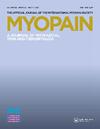Other Soft Tissue Pain Conditions
引用次数: 0
Abstract
This article was a cross sectional study conducted in the Loire Valley area of west central France. The subjects were randomly selected from workers undergoing the mandatory annual health examination between April 2002 and April 2005. Eighty-three occupational physicians participated in the study. All were trained by the investigators to perform a standardized physical examination, and criteria for the diagnosis of knee bursitis were applied. The criteria were pain and/or tenderness in the anterior face of the knee on the day of the examination or hurting at least four days in the preceding week and swelling or pressure induced pain in the pre-infra patellar bursa. The study population comprised 3710 workers, and 58% were men. The mean age was 38.7 10.3 years. Two percent of the workers refused to participate in this study and another five percent thought there was not enough time to complete the questionnaire or the physical examination. In the remaining study population, 21 cases of new bursitis were diagnosed in 15 workers [12 men] and 40% were bilateral. The overall prevalence of unior bilateral cases of knee bursitis was 0.4%. The highest prevalence in men was observed in the young [20–29 years] and middle aged [30–39 years] workers. Knee bursitis was most prevalent in the construction sector and in the food and meat processing industries. Blue-collar workers were more often affected than other occupation categories. Those blue-collar skilled workers such as painters, floor layers, plumbers and builders, were more likely to have knee bursitis. Truck drivers are also higher up on the list, below the skilled crafts blue-collar workers. Overall, the prevalence of unior bilateral cases of knee bursitis was fairly low: 0.6% in men and 0.2% in women.其他软组织疼痛状况
本文是在法国中西部卢瓦尔河谷地区进行的横断面研究。研究对象是从2002年4月至2005年4月期间接受强制性年度健康检查的工人中随机选择的。83名职业医生参与了这项研究。所有研究人员都训练他们进行标准化的身体检查,并应用诊断膝关节滑囊炎的标准。标准为检查当天膝关节前面疼痛和/或压痛,或前一周疼痛至少4天,髌下前滑囊肿胀或压痛。研究人群包括3710名工人,其中58%是男性。平均年龄为38.7 - 10.3岁。2%的员工拒绝参加这项研究,另有5%的人认为没有足够的时间完成调查问卷或身体检查。在剩余的研究人群中,15名工人(12名男性)中诊断出21例新发滑囊炎,其中40%为双侧。单侧双侧膝关节滑囊炎病例的总体患病率为0.4%。男性患病率最高的是青年[20-29岁]和中年[30-39岁]工人。膝关节滑囊炎在建筑行业以及食品和肉类加工行业最为普遍。蓝领工人比其他职业更容易受到影响。那些蓝领技术工人,如油漆工、地板工人、水管工和建筑工人,更容易患膝滑囊炎。卡车司机的排名也更高,低于熟练的工艺蓝领工人。总体而言,单侧双侧膝关节滑囊炎病例的患病率相当低:男性为0.6%,女性为0.2%。
本文章由计算机程序翻译,如有差异,请以英文原文为准。
求助全文
约1分钟内获得全文
求助全文

 求助内容:
求助内容: 应助结果提醒方式:
应助结果提醒方式:


